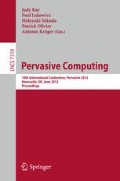Abstract
RFID technology is now widely used to identify, locate, track and monitor physical objects. However, the use of RFID technology in modern manufacturing has been limited because of the unreliability of RFID devices. In addition to this, where it is used, the technology is mostly deployed to be a substitute for manual inventory management. In this paper we present the Smart Factory, a modern factory infrastructure capable of monitoring each and every product part that moves across the factory during the entire production process. In order to overcome the reliability issues in RFID devices, we have built up a probabilistic model to assign probabilities to the RFID readers and to the product part detections. We also present a probability self-calibration algorithm that automatically adapts the probabilities of RFID readers to better reflect their performance at current instance of time.
Access this chapter
Tax calculation will be finalised at checkout
Purchases are for personal use only
Preview
Unable to display preview. Download preview PDF.
References
Khodawandi, D.: Principal of Porsche Consulting, Manufacturing (2011)
Johnson, D.: WebMon: RFID tags improve tracking, quality on Ford line in Mexico. Engineering 49(11), 16 (2002)
Brewer, A., Landers, T.: Radio Frequency Identification: A Survey and Assessment of the Technology. Technical Report, University of Arkansas, Department of Industrial Engineering (1997)
Zhekun, L., Gadh, R., Prabhu, B.S.: Applications of RFID technology and smart parts in manufacturing. In: Proceedings of DETC 2004: ASME 2004 Design Engineering Technical Conference and Computers and Information in Engineering Conference, Salt Lake City, Texas (2004)
Ahmed, N., Kumar, R., French, R.S., Ramachandaran, U.: RF2ID: A reliable middleware framework for RFID deployment. In: Proceedings of IEEE IPDPS. IEEE Computer Society Press (2007)
Prabhu, B.S., Su, X., Ramamurthy, H., Chu, C.-C., Gadh, R.: WinRFID – A Middleware for the enablement of Radio Frequency Identification (RFID) based Applications. In: Mobile, Wireless and Sensor Networks Technology, Applications and Future. John Wiley and Sons, Inc. (2005)
The Basics of RFID Technology, http://www.rfidjournal.com/article/articleview/1337/1/129/
Hassan, T., Chatterjee, S.: A Taxonomy for RFID. In: HICSS 2006: Proc. of the Intl. Conf. on System Sciences. IEEE Computer Society (2006)
Hameed, B., Khan, I., Durr, F., Rothermel, K.: An RFID Based Consistency Management Framework for Production Monitoring In a Smart Real-Time Factory. In: Proceedings of 2010 Internet of Things Conference, Tokyo- Japan (Best Paper Award) (2010)
Lucke, D., Constantinescu, C., Westkamper, E.: Smart factory - a step towards the next generation of manufacturing. In: Manufacturing Systems and Technologies for the New Frontier. Springer (2008)
Oat Systems and MIT Auto-ID Center: The Savant. Technical Manual (2002)
Li, T., Wang, D.: Experimental studying measurement metrics of RFID system performance. In: ASID 2009 Proc. of the 3rd International Conference on Anti-Counterfeiting, Security, and Identification in Communication (2009)
Franklin, M.J., Jeffery, S.R., Krishnamurthy, S., Reiss, F.: Design Considerations for High Fan-in Systems: The HiFi Approach. In: CIDR (2005)
Floerkemeier, C., Lampe, M.: RFID middleware design: addressing application requirements and RFID constraints. In: sOc-EUSAI 2005: Proc. of the 2005 Joint Conf. on Smart Objects and Ambient Intelligence (2005)
Weinstein, R.: RFID: A Technical Overview and Its Application to the Enterprise. IT Professional 7(3) (2005)
McCarren Airport RFID System Takes Off, http://www.rfidjournal.com/article/view/1949/1/1
De, P., Basu, K., Das, S.K.: An Ubiquitous Architectural Framework and Protocol for Object Tracking Using RFID Tags. In: Proc. of the Intl. Conf. on Mobile and Ubiquitous Systems: Networking and Services (2004)
Yap, K.-K., Srinivasan, V., Motani, M.: MAX: human-centric search of the physical world. In: Sensys (2005)
Kumar, S., Alaettinoglu, C., Estrin, D.: SCalable Object-tracking through Unattended Techniques (SCOUT). In: Proc. of the Intl. Conf. on Network Protocols, ICNP (2000)
Vogt, H.: Efficient Object Identification with Passive RFID Tags. In: Mattern, F., Naghshineh, M. (eds.) PERVASIVE 2002. LNCS, vol. 2414, p. 98. Springer, Heidelberg (2002)
Kodialam, M., Nandagopal, T.: Fast and Reliable Estimation Schemes in RFID Systems. In: Proceedings of MobiCom (2006)
Lehtonen, M., Michahelles, F., Fleisch, E.: How to detect cloned tags in a reliable way from incomplete RFID traces. In: IEEE International Conference on RFID (2009)
Rahmati, A., Zhong, L., Hiltunen, M., Jana, R.: Reliability Techniques for RFID-Based Object Tracking Applications. In: Dependable Systems and Networks (2007)
Lernfabrik video, http://www.youtube.com/watch?v=hyetywtayVI
PeerSim: A Peer-to-Peer Simulator, http://peersim.sourceforge.net/
Volare RFID readers, http://www.kenetics-group.com/data/Volare/Volare%20UHF-USB.pdf
Author information
Authors and Affiliations
Editor information
Editors and Affiliations
Rights and permissions
Copyright information
© 2012 Springer-Verlag Berlin Heidelberg
About this paper
Cite this paper
Hameed, B., Rashid, F., Dürr, F., Rothermel, K. (2012). Self-calibration of RFID Reader Probabilities in a Smart Real-Time Factory. In: Kay, J., Lukowicz, P., Tokuda, H., Olivier, P., Krüger, A. (eds) Pervasive Computing. Pervasive 2012. Lecture Notes in Computer Science, vol 7319. Springer, Berlin, Heidelberg. https://doi.org/10.1007/978-3-642-31205-2_16
Download citation
DOI: https://doi.org/10.1007/978-3-642-31205-2_16
Publisher Name: Springer, Berlin, Heidelberg
Print ISBN: 978-3-642-31204-5
Online ISBN: 978-3-642-31205-2
eBook Packages: Computer ScienceComputer Science (R0)

